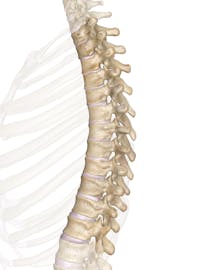The Thoracic Vertebrae
Explore the anatomy, structure, and function of the thoracic vertebrae with Innerbody's interactive 3D model.

The thoracic vertebrae are a group of twelve small bones that form the vertebral spine in the upper trunk. Thoracic vertebrae are unique among the bones of the spine in that they are the only vertebrae that support ribs and have overlapping spinous processes. Like all other vertebrae, the thoracic vertebrae help to support the weight of the upper body and protect the delicate spinal cord as it runs through the vertebral canal.
The thoracic vertebrae are located in the thorax posterior and medial to the ribs. They form the region of the spinal column inferior to the cervical vertebrae of the neck and superior to the lumbar vertebrae of the lower back. Each thoracic vertebra is named for its position within the spine, from the first thoracic vertebra (T1) on the superior end to the twelfth thoracic vertebra (T12) on the inferior end. The spinal column formed by the thoracic vertebrae protrudes posteriorly to form the convex thoracic curve of the spine.
The thoracic vertebrae are medium in size --- larger and thicker than the cervical vertebrae above them, but smaller and thinner than the lumbar vertebrae below. The T1 vertebra is the smallest and closely resembles the cervical vertebrae, while the T12 vertebra is the largest and most similar to the lumbar vertebrae. The intermediate vertebrae all follow the trend of increasing size from superior to inferior as a result of the greater body weight supported by the inferior vertebrae.
The bulk of the bony mass of the thoracic vertebrae is located within a cylindrical region known as the vertebral body or centrum. Each thoracic vertebra supports a pair of ribs and contains a pair of smooth, concave joint-forming processes known as facets on its sides. The ribs are anchored to the spine by the planar joints formed between the vertebrae and the ribs. The first nine thoracic vertebrae (T1 through T9) contain a pair of demi-facets, where a facet is split between two adjacent vertebral bodies. Meanwhile, the first, tenth, eleventh, and twelfth (T1, T10, T11 and T12) vertebrae all contain a pair of full facets on their vertebral bodies to support ribs. T1 is unique among all thoracic vertebrae in supporting two pairs of ribs through a pair of facets and a pair of demi-facets.
Between the vertebral bodies of the thoracic vertebrae are the tough, rubbery intervertebral disks. Each disk is made of an outer shell of fibrocartilage known as the annulus fibrosus, which holds the vertebrae in place while providing a small range of motion between them. Inside the annulus fibrosus is the gel-like nucleus pulposus that acts as a soft shock absorber to prevent collisions between the vertebrae.
Posterior to the vertebral bodies are thin bony rings known as the vertebral arches. Each vertebral arch surrounds and protects a hollow vertebral foramen that provides space for the spinal cord and spinal nerves. A pair of transverse processes extends from the lateral sides of each vertebral arch to support the ribs and provide attachment sites for the rotatores and multifidus muscles of the back. At the posterior end of the vertebral arch, each thoracic vertebra extends posteriorly and inferiorly to form the spinous processes. Each spinous process supports several muscles of the back to provide movement to the trunk and spine region. The spinous processes also overlap each other slightly to provide extra support and rigidity to the thoracic region and prevent extraneous movements.
Two pairs of articular processes extend superiorly and inferiorly toward the neighboring vertebrae, in order to help stabilize the spine and connect the thoracic vertebrae to one another and to the C7 and L1 vertebrae. Flat planar joints form between the articular processes of these neighboring vertebrae, allowing the bones to move independently while maintaining the strength and stability of the spinal column. The superior articular processes end in smooth surfaces facing posteriorly to meet the articular process of the vertebra above. On the inferior end, the inferior articular processes end in smooth, flat surfaces facing anteriorly to meet the next vertebra. The T1 and T12 vertebrae are the exceptions to this rule; T1 features a superior articular process resembling those of the cervical vertebrae, while the inferior articular process of T12 resembles those of the lumbar vertebrae.


